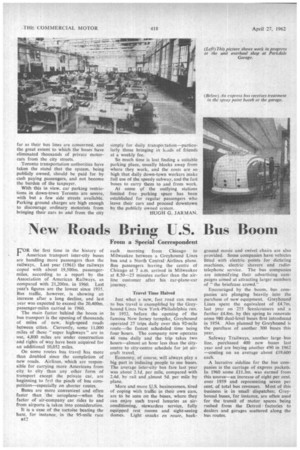New Roads Bring U.S. Bus Boom
Page 46

If you've noticed an error in this article please click here to report it so we can fix it.
From a Special Correspondent
FOR the first time in the history of American transport inter-city buses are handling more passengers than the railways. Last year (1961) the railways coped with about .19,500m. passengermiles, according to a report by the Association of American Railways, as compared with 21,200m. in 1960. Last year's figures are the lowest since 1935„ Bus traffic, however, is showing an increase after a long decline, and last year was expected to exceed the 20,400m. passenger-miles carried in 1960.
The main factor behind the boom in bus transport is the opening of thousands of miles of new, high-speed roads between cities. Currently, some 11,000 miles of these "super highways" are in use, 4,800 miles are under construction and rights of way have been acquired for an additional 10,052 miles.
On some routes bus travel has more than doubled since the completion of new roads. Airlines, which are responsible for carrying more Americans from city to city than any other form of transport except the private car, are beginning to fefl the pinch of bus competition—especially on shorter routes.
• Buses are more convenient and often faster than the aeroplane—when the factor of air-company car rides to and from airports is taken into consideration.
It is a case of the tortoise beating the hare, for instance, in the 95-mile race
each morning from Chicago to Milwaukee between a Greyhound Lines bus and a North Central,Airlines plane. Bus passengers leaving the centre of Chicago at 7 a.m, arrived in Milwaukee at 8.50-25 minutes earlier than the airline customer after his car-plane-ear journey,
Travel Time Halved Just what a new, fast road can mean to bus travel is exemplified by the Greyhound Lines New York-Philadelphia run. In 1952, before the opening of the famous New Jersey turnpike, Greyhound operated 27 trips daily over this 92-mile route--the fastest scheduled time being four hours. The company now operates 46 runs daily and the trip takes two hours—almost an hour less than the citycentre to city-centre schedule for jet aircraft travel.
Economy, of course, will always play a big part in inducing people to use buses. The average inter-city bus fare last year was about 2.1d, per mile, compared with 2.4d, by rail and almost 5d. per mile by plane.
More and more U.S. businessmen, tired of coping with traffic in their own cars, are to be seen on the buses, where they can enjoy such travel luxuries as airconditioning, stewardess service, fully equipped rest rooms and sight-seeing domes. Light snacks en route, back
ground music and swivel chairs are also provided. Some companies have vehicles fitted with electric points for dictating machines, electric shavers and radiotelephone service. The bus companies are intensifying their advertising campaigns aimed at attracting larger numbers of "the briefcase crowd."
Encouraged by the boom, bus companies are plunging heavily into the purchase of new equipment. Greyhound Lines spent the equivalent of £4.7m. last year on 255 Scenicruisers and a further £4.8m. by this spring to renovate some 980 dual-level buses first introduced in 1954. Also planned by Greyhound is the purchase of another 300 buses this year.
Safeway Trailways, another large bus line, purchased 400 new buses last year and are buying another 490 in 1962 —costing on an average about £19,600 each.
A lucrative sideline for the bus companies is the carriage of express packets. In 1960 some £113m. was earned from this source—an increase of eight per cent. over 1959 and representing seven per cent, of total bus revenues. Most of this business is in small dispatches; Greyhound buses, for instance, are often used for the transit of motor spares being rushed from the Detroit factories to dealers and garages scattered along the bus routes.




















































































































